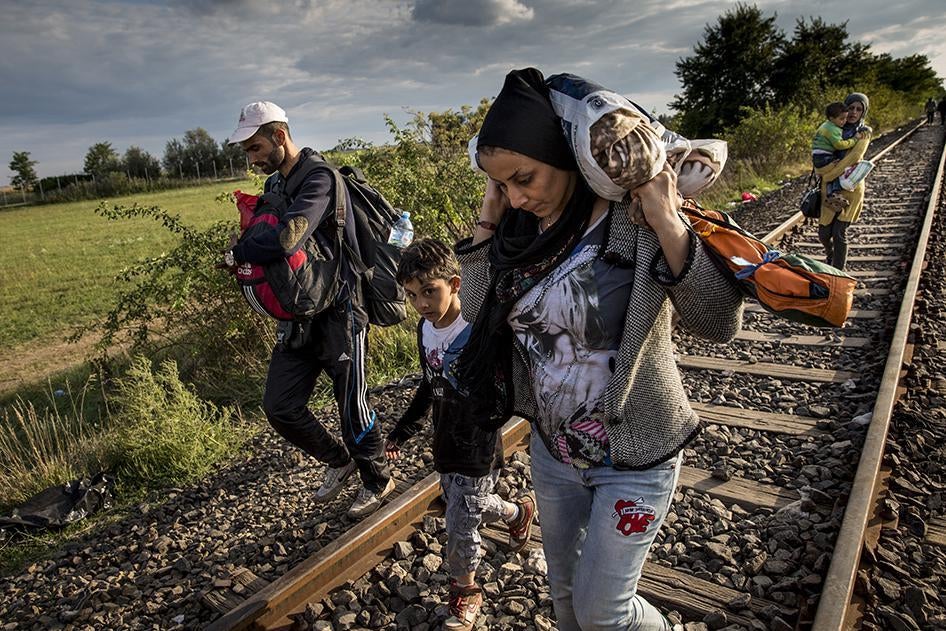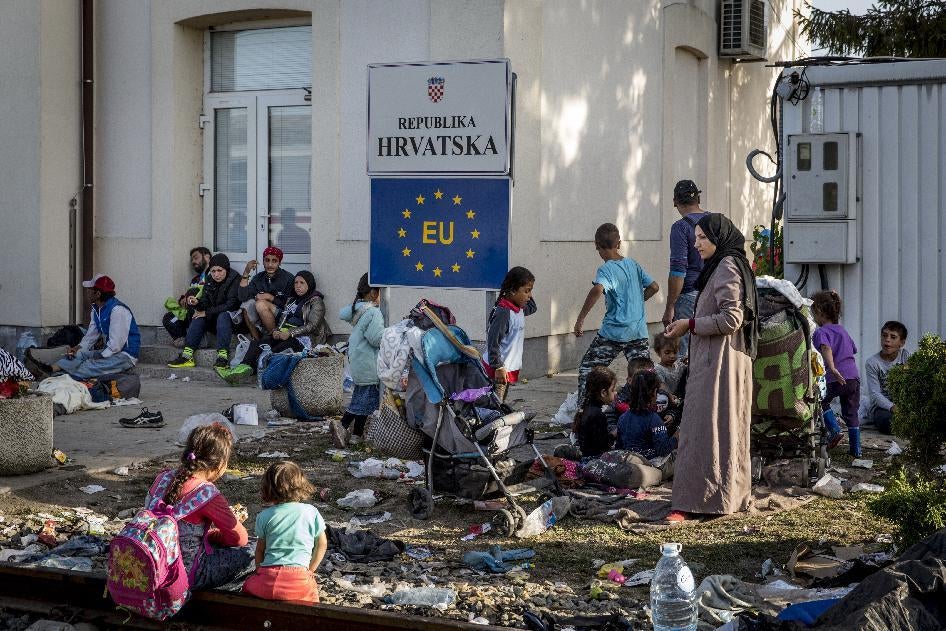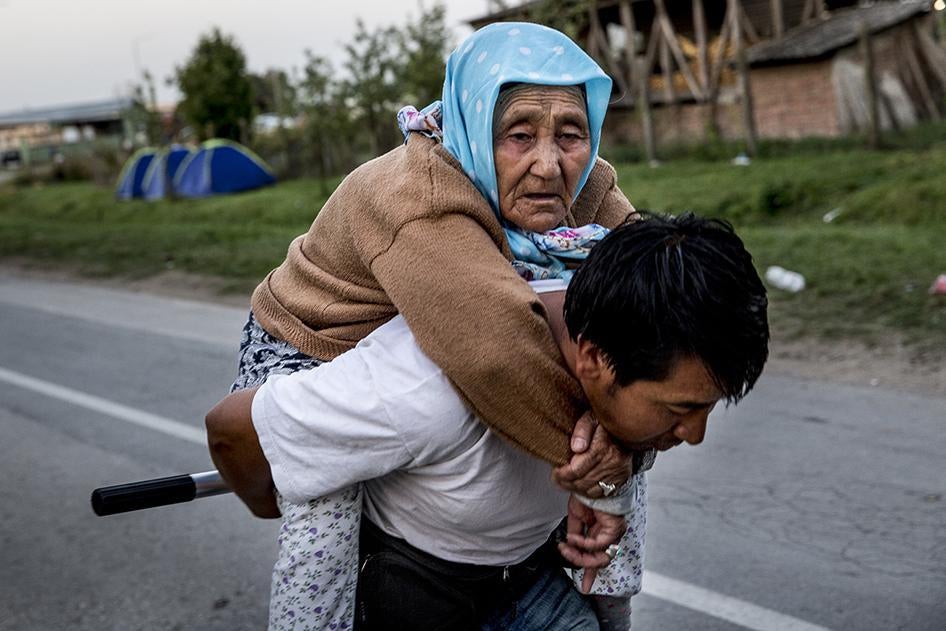Members of the Greek coast guard, on a rescue mission, throw a life ring to a person in distress in the sea near the Greek island of Lesbos, after he jumped from a sinking rubber dingy. October 4, 2015.
© 2015 Zalmaï for Human Rights Watch
Mostly Syrian asylum seekers and migrants are rescued off a drifting rubber dinghy found by a Greek coast guard vessel on a rescue mission near the island of Lesbos in Greece. October 4, 2015.
© 2015 Zalmaï for Human Rights Watch
18-year-old Mohammed, who said he lost both legs to a Syrian airstrike in Idlib in 2012, is carried by friends on the island of Lesbos in Greece. Both his friends and relatives accompanied him on his journey to safety, carrying him whenever needed. October 8, 2015.
© 2015 Zalmaï for Human Rights Watch
Syrian toddlers sleep at the port in Mytilene on Lesbos island in Greece. Their family was waiting to board a midnight ferry to Athens. October 5, 2015.
© 2015 Zalmaï for Human Rights Watch
Asylum seekers and migrants descend from a large fishing vessel used to transport them from Turkey to the Greek island of Lesbos. October 11, 2015.
© 2015 Zalmaï for Human Rights Watch
A family of Afghan asylum seekers waits to enter the Moria registration center on the Greek island of Lesbos. Many families with children say they are too afraid to wait in line for registration. October 4, 2015.
© 2015 Zalmaï for Human Rights Watch
Hungarian police stand in front of the entrance to the Keleti train station in Budapest, Hungary barring entry to the many refugees and asylum seekers who wait to board trains to Germany. September 1, 2015.
© 2015 Daniel Etter for Human Rights Watch
Safi, 30, (right) a Syrian refugee from Aleppo, walks on highway M1 near Budapest, Hungary in an attempt to reach Vienna, Austria by foot after Hungarian authorities refused to allow refugees and asylum seekers to board trains that would take them to Germany. September 4, 2015.
© Daniel Etter for Human Rights Watch.
Newly arrived families with children walk along the railway tracks from Serbia into Hungary, towards the Roszke collection point in Hungary where they will be taken in buses to temporary detention camps. September 8, 2015.
© 2015 Zalmaï for Human Rights Watch
A woman carries her child in the rain along the railroad tracks after crossing the Hungary border from Serbia, heading towards the Roszke collection point where they will board a bus to a temporary detention camp. September 10, 2015.
© 2015 Zalmaï for Human Rights Watch
Ali, a young Iraqi boy, is reunited with his family after becoming separated from them at a Roszke detention camp in Hungary. September 10, 2015.
© 2015 Zalmaï for Human Rights Watch
Hungarian army officers patrol with their dogs along the newly finished razor-wire fence erected on the border with Serbia. Sept. 13, 2015.
© 2015 Zalmaï for Human Rights Watch
A small boy protests at the Tovarnik train station, calling on the Croatian police to allow the overcrowded train to proceed to Zagreb. The train had been held in the station for 6 hours, as the Croatian authorities tried to cope with the sudden influx of thousands from the Serbian border. September 18, 2015.
© 2015 Zalmaï for Human Rights Watch
An estimated 10,000 newly arrived asylum seekers and migrants arrived overnight in the small Croatian border village of Tovarnik, following the closure of the Hungarian border with a razor wire fence. September 18, 2015.
© 2015 Zalmaï for Human Rights Watch
Thousands of asylum seekers and migrants sleep on the concrete in the small Croatian border town of Tovarnik after arriving from Serbia, waiting for trains or buses to take them onwards. September 18, 2015.
© 2015 Zalmaï for Human Rights Watch
A family sleeps in a field near Tovarnik, Croatia, after crossing the border from Serbia. The small village of Tovarnik was overwhelmed by the overnight arrival of an estimated 10,000 asylum seekers and migrants, following the closure of the Hungary border with a razor-wire fence. September 18, 2015.
© 2015 Zalmaï for Human Rights Watch
Asylum seekers and migrants try to board an overcrowded train leaving the small Croatian border village of Tovarnik, hoping to go towards the country’s capital, Zagreb. September 18, 2015.
© 2015 Zalmaï for Human Rights Watch
Hussein, an Afghan asylum seeker, carries his 82-year-old mother on his back waiting in line to board a bus at Tovarnik, Croatia. September 18, 2015.
© 2015 Zalmaï for Human Rights Watch
Between January 1 and the end of November 2015, more than 886,000 people reached the EU via the Mediterranean, a significant increase over previous years. More than 3,500 people died or went missing in the same period while making the journey. Arrivals to Greece via Turkey across the Aegean Sea now far outstrip crossings via Libya to Italy. From Greece, a debt-stricken country unable to cope with the influx, many travel overland through the Western Balkans to reach other EU countries. The land route contains its own perils, including blocked border crossings, summary expulsions and police abuse.
Over 80 percent of those taking the dangerous journey originate from countries beset by war, generalized violence, or with repressive governments, such as Syria, Eritrea, Somalia, Afghanistan, and Iraq. The EU continues to emphasize preventing departures and combating smuggling over a coordinated approach based on access to protection and respect for human rights including through problematic cooperation with Turkey and other transit countries.























